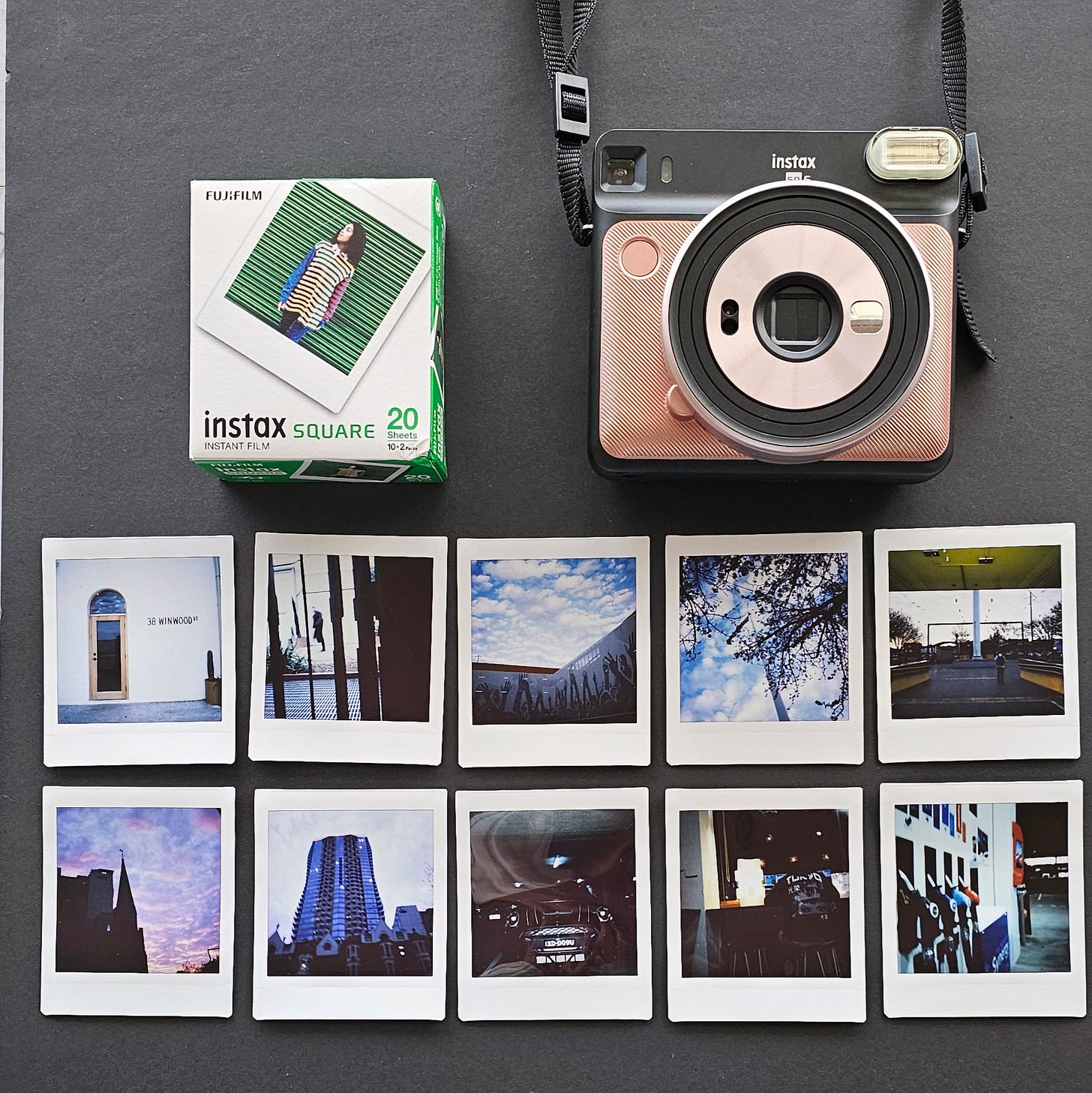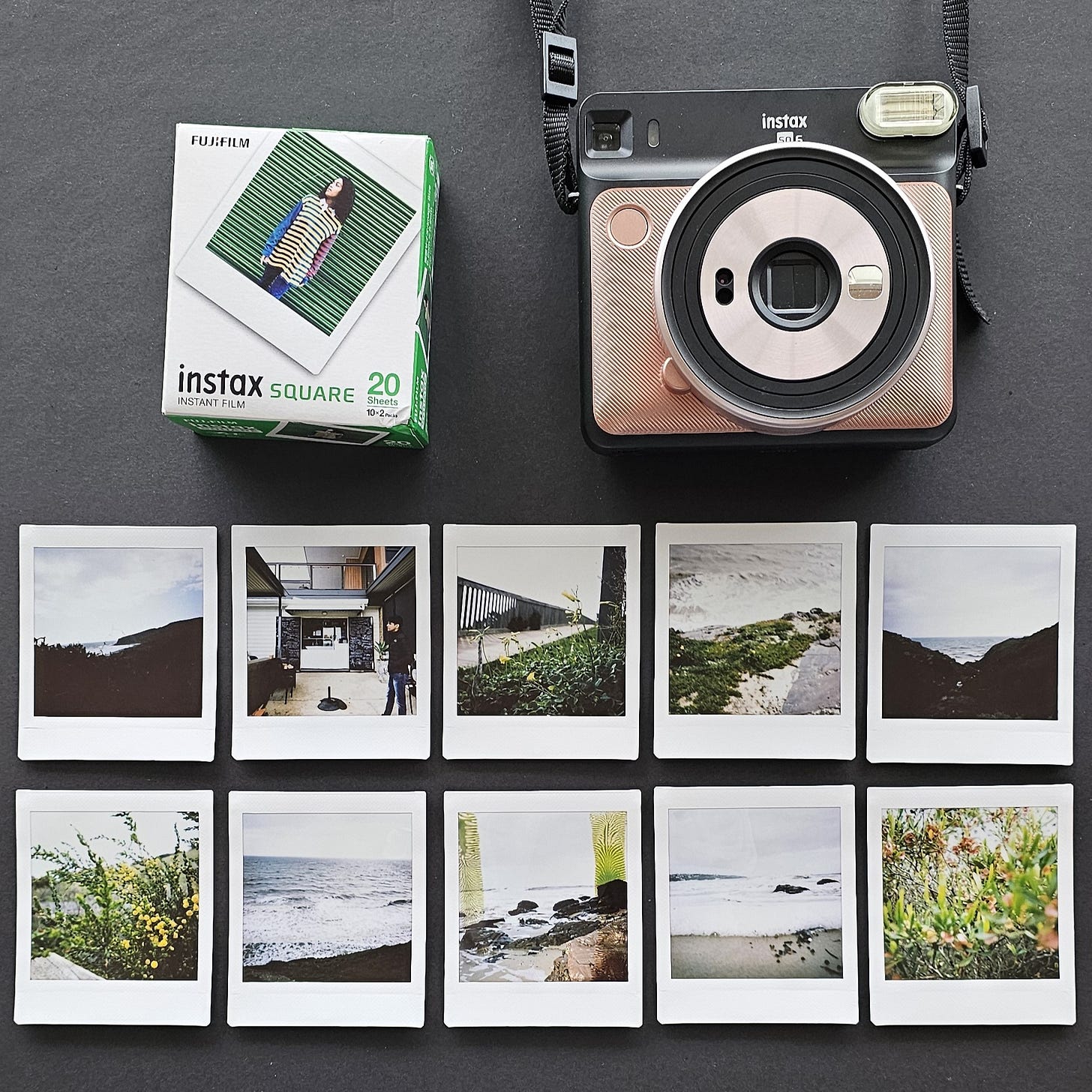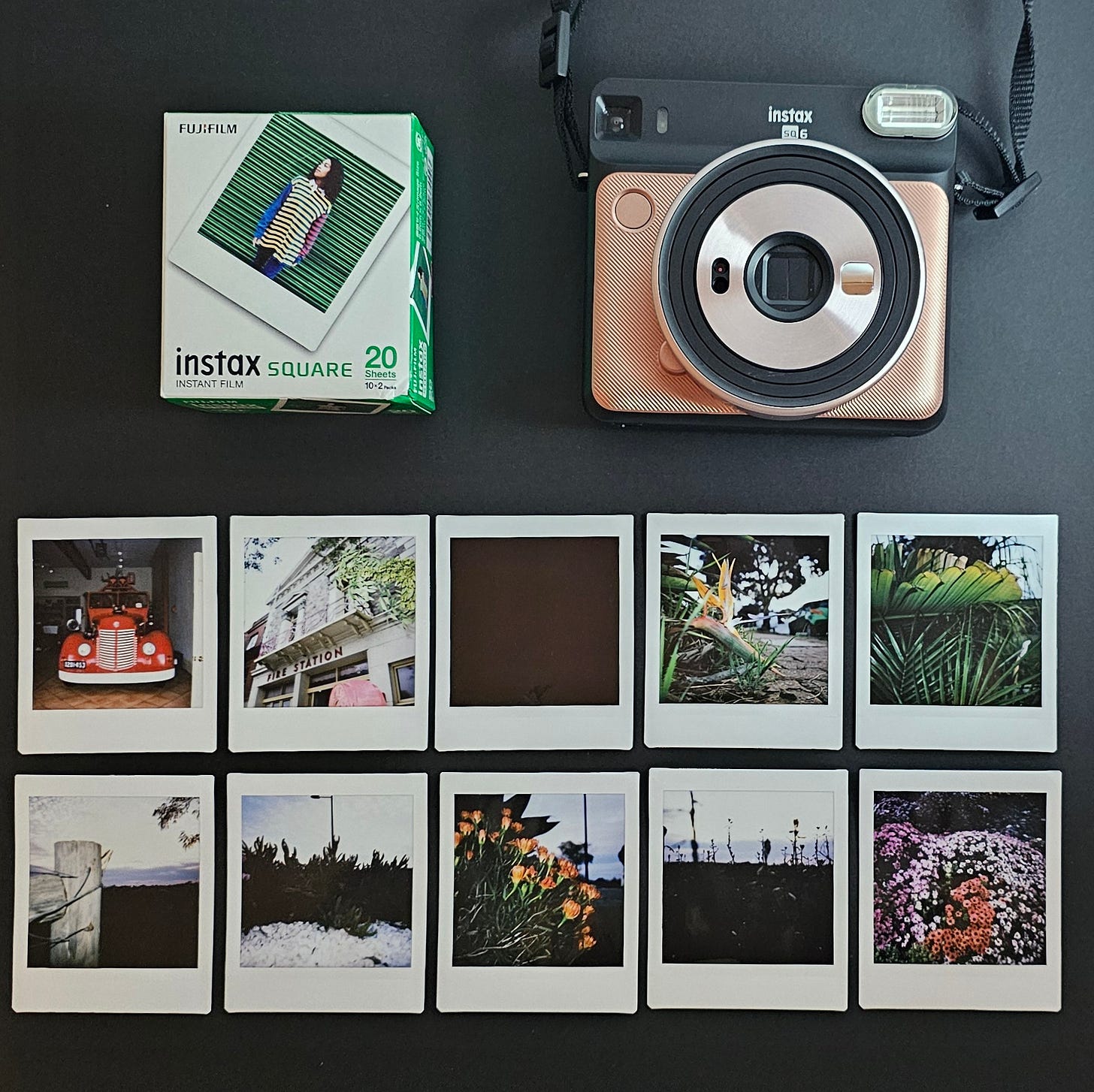Tangible Photography Tales: 100 Instax SQ6 Snapshots
On Completing a 100 Things Project
When I first embarked on my Instax SQ6 adventure, it was merely the beginning of my first instant photography challenge within the 100 Things Project format. Purchasing the Instax SQ6 in July, I set myself a goal: take at least 100 photos to gauge my feelings about instant photography.
Fast forward three months, and I've not only surpassed the 100-photo mark with my Instax SQ6 but have fallen head over heels for the medium. This newfound passion has led me to:
Acquire my first ever Instax Wide camera; and
Add a Polaroid Go 2 to my growing collection of instant cameras
To say I'm completely hooked would be an understatement.
As I celebrate this milestone - my first completed 100 Things Project of the year - I'm excited to share my journey, along with the lessons learned, tips discovered, and stories behind these tangible snapshots.
Join me as we explore the world through the lens of instant photography, one square frame at a time.
1st Pack (Photos 1 to 10)
My initial adventures with my Instax SQ6* have been extensively documented across various platforms, including here on Substack. And, among the 100 snapshots that chronicle this adventure, one stands out as my absolute favourite - the image captured beneath the jetty. Seeing that photo got me completely hooked on this medium. Not to mention, the memory of that day - venturing to the windswept beach with my kids, braving the elements, and exploring the quirks of my new camera - is forever imprinted not just on film, but in my mind.
Some key lessons:
Framing is an art form with the square format. The Instax SQ6's parallax error turns each shot into a bit of a guessing game. It's like trying to do blind contour drawing - frustrating at first, but oddly freeing. With practice, you develop some sense of composition, turning limitations into creative opportunities.
Imperfection is more than just okay; it's the secret sauce. In the world of instant photography, flaws become features. The slightly soft focus, the dreamy faded colours, the occasionally off-kilter framing - these aren't bugs in the system, they're the brush strokes that make each image uniquely charming. Embracing these quirks is where the real magic happens.
2nd Pack (Photos 11 to 20)
For my second pack, I decided to push beyond the Instax SQ6's basic modes. Point-and-shoot, flash-off, and exposure compensation took a back seat as I set out to explore the camera's more intriguing features. The self-timer and double exposure mode became my new playground, resulting in a collection where 8 out of 10 photos are self-portraits and all but one are double exposures. This experimental journey was exciting, but it also humbled me - while I loved exploring double exposures, I realised I still have a long way to go before I can truly master this function.
Some key lessons:
Developing a theme per pack of film creates a cohesive narrative. In this series, the selfie and double exposure approach wove the photos together. However, the lone 'outsider' photo at the end felt out of place. This taught me the power of consistency within a pack, even if it's less crucial when viewing photos individually. The challenge of unifying shots from different days made me appreciate the seamless flow of the first pack even more.
Double exposures demand deliberate design. It's not just about pressing the shutter twice and hoping for the best. Careful consideration of which image takes the lead, along with a keen awareness of light and shadow interplay, can elevate a double exposure from interesting to extraordinary. This forethought is key to creating compelling multi-layered images.
3rd Pack (Photos 21 to 30)
This third pack, like its predecessor, spans different days and themes, resulting in a less cohesive collection than I'd initially envisioned. Despite this, the pack is rich with cherished memories: a nature walk with my daughter for her Year 12 geography project, a cozy coffee date with my son, a salon trip with my daughter, and a subsequent stroll across the city. These snapshots, while diverse, capture slices of life that I treasure.
Some key lessons:
Stories and memories are the heart of photography. While aesthetically pleasing compositions are gratifying, even blurry or poorly framed shots can encapsulate beautiful moments. The technical imperfections often fade in importance when the image evokes a strong emotional response or preserves a significant memory.
Mastering the horizon line is crucial, but rules are made to be broken. Keeping the horizon straight generally results in more polished images. However, I've found that deliberately angled shots can add dynamism and interest to a composition when used thoughtfully.
Flash photography is a tool, not a foe. I've typically favoured natural light, often shooting with the flash off. However, these instant cameras struggle in low-light conditions. I've learned that when in doubt, it's better to err on the side of using flash – it can mean the difference between capturing a moment and losing it to darkness.
4th Pack (Photos 31 to 40)
This fourth pack marked a shift in my approach - all 10 photos were captured on the same day, yet they span various themes. It also presented a new challenge: for the first time in this project, one of the photos failed to develop properly, offering an unexpected learning opportunity.
Some key lessons:
Dark backgrounds demand careful consideration, especially without flash. The second image in this pack fell victim to this pitfall, failing to develop properly. I don’t usually re-take an image with instant cameras, but in this instance, I attempted to rectify this in the fifth shot by using flash. While the result wasn't perfect, it at least ensured the subject was captured on film. This experience underscored the importance of assessing lighting conditions and adjusting camera settings accordingly.
Never underestimate the photogenic potential of clouds. Initially, I was skeptical about dedicating shots to clouds, assuming they'd yield mundane images. To my surprise, this series turned out to be quite compelling. It served as a powerful reminder that creating a series can elevate seemingly simple subjects into an engaging collection. Sometimes, beauty lies in the consistency and subtle variations of a repeated theme.
5th Pack (Photos 41 to 50)
This pack, though captured on two separate occasions, maintains a thematic consistency within each set. The first series features my daughter as a model, exploring how the SQ6 performs in a dimly lit room with basic studio lighting. Despite the lack of flash resulting in slightly grainy images, I thoroughly enjoyed this shoot, with the third photo emerging as my favourite. The second set, taken in my backyard, was an experiment with the macro mode, teaching me the importance of maintaining the correct distance (in my case, an arm's length) for optimal focus.
Some key lessons:
The Instax SQ6 shows promise for portraiture, with some caveats. I've found the camera quite capable for portrait photography, but it requires getting closer to the subject for best results. In low-light situations, using a tripod would significantly improve image quality and sharpness. These adjustments could elevate the portraits from good to exceptional.
Instax Square film can capture surprisingly vibrant colours under the right conditions. Both sets in this pack revealed a more colourful palette than I'd previously experienced, which was a delightful discovery. This vibrancy adds a new dimension to the instant photography experience, proving that these small squares can pack quite a visual punch when the conditions are right.
6th Pack (Photos 51 to 60)
The sixth pack in this 100 Things Project marks the second instance where I completed an entire pack in a single day. These images chronicle my journey home from the office - capturing moments from my walk to the tram stop, the tram ride itself, my stroll to the car park where I met my husband, our dinner at one of our favourite restaurants, and finally, a petrol stop. I'm particularly fond of how this set weaves together to narrate the story of my evening. Several images from this collection (1, 3, 5, 6, and 10) stand out as personal favourites, reinforcing the value of using an entire pack to capture a cohesive narrative.
Some key lessons:
Revisiting favoured themes builds a compelling collection. I found that returning to subjects like clouds, doors, and vanishing perspectives not only yielded some of my favourite shots but also contributed to a sense of continuity and depth in my overall project. This approach allows for both consistency and the opportunity to refine techniques over time.
Street photography is achievable with the Instax SQ6, albeit with unique challenges. The camera's slight delay between pressing the shutter and capturing the image requires a different approach to timing. Despite this, images 2, 5, and 9 represent my first successful attempts at translating my typical street photography style - incorporating human elements into urban scenes - into the instant format. This experience highlighted both the limitations and the unique potential of instant cameras in capturing fleeting street moments.
7th Pack (Photos 61 to 70)
This pack marks another instance where I completed all ten shots in a single day and location, accompanying my daughter to a local conservation park for her geography project once again. Despite the shared setting, I experimented with varied subjects and approaches. Interestingly, I encountered a peculiar 'malfunction' for the second time in my project - image 8 developed with strange green markings, the cause of which remains a mystery. Overall, this pack ranks as my least favourite, with only images 2 and 3 (one in street photo style, both featuring architectural elements) standing out as personal highlights.
Some key lessons:
The Instax SQ6 has limitations in landscape photography. This observation, later corroborated by other instant camera reviews I've come across, stems from the print size and other inherent constraints of the format. These limitations are particularly noticeable on overcast days, which have been common during my winter shooting sessions. For nature photography with this camera, I've found it's more effective to focus on detailed shots or singular subjects, such as a flower or a tree, rather than sweeping vistas.
Experimenting with unconventional angles can yield intriguing results, even with familiar subjects. However, this approach requires patience and practice, especially when working with instant cameras. The immediate nature of the medium means each experiment comes with a tangible cost, both in film and opportunity. Moving forward, I'm keen to explore seascape photography under various lighting conditions, applying this lesson of finding fresh perspectives on familiar scenes.
8th Pack (Photos 71 to 80)
This pack spans two distinct occasions: the first five shots capturing Father's Day and the arrival of spring, while the latter half documents a sunset walk around the neighbourhood on a cloudy day. The indoor shots for Father's Day reinforced the crucial role of flash, particularly evident in the retake of image 1 as image 3. Despite the sunset series yielding mostly disappointing results, this pack produced some of my favourite photos from the entire project. The portrait of my son and the door shot stand out as particular highlights, while the Father's Day snapshots serve as cherished mementos.
Some key lessons:
The Instax SQ6 struggles with evening photography, revealing its further limitations in low-light conditions. Even when the ambient light seems sufficient for digital cameras (my phone camera captured the scenes beautifully), the instant camera falls short. This stark contrast highlights the technological gap between digital and instant photography. However, this limitation led to an unexpected positive: the silhouette shots of flowers (images 6 and 7) turned out surprisingly appealing, showcasing how constraints can sometimes yield creative results.
Dark subjects, especially in low light, pose a significant challenge for the Instax SQ6. Even with flash, these subjects tend to produce unsatisfactory results. Image 8, intended to capture a dark succulent, exemplifies this issue. This experience underscores the importance of subject selection and lighting conditions when working with instant cameras. It's a reminder that instant photography often requires a different approach to subject choice and composition compared to digital photography.
9th Pack (Photos 81 to 90)
This pack represents another diverse collection, spanning two distinct outings: a city walk during a work event and a sunset stroll in the neighbourhood. Once again, I encountered a development malfunction (image 3), which I recall was another attempt at capturing a dark succulent during sunset, albeit in seemingly better lighting conditions. Despite a few disappointing shots, this pack yielded some personal favourites, particularly images 1, 2, and 4. Image 9 stands out as another floral silhouette, this time boasting more vibrant background colours.
Some key lessons:
Optimal lighting and vibrant subjects are a winning combination for the Instax SQ6. While the camera may struggle during grey, overcast sunsets, it truly shines in golden hour lighting, especially when paired with flash for brightly coloured subjects. The vivid red fire truck proved to be an exceptionally fun and photogenic subject, showcasing the camera's ability to capture rich, saturated colours under the right conditions.
Experimenting with low-angle shots can yield surprisingly impressive results, despite the challenges. Taking photos from a low perspective (as in images 4, 6, and 7) requires a leap of faith, as it's nearly impossible to use the viewfinder unless you're willing to lie flat on the ground. This approach relies heavily on instinct and spatial awareness, making each shot a bit of a gamble. However, the potential payoff is significant, as evidenced by the striking composition of image 4. These low-angle shots add a unique dimension to the collection, offering fresh perspectives on familiar scenes.
10th Pack (Photos 91 to 100)
The tenth and final pack of this project presents another eclectic mix, capturing diverse scenes around my workplace and the city on separate occasions. While some experimental shots didn't yield the desired results, I value the learning experience they provided. The standout image from this set is number 5, which I particularly appreciate for its captivating textures and colours of a fallen, dried gum tree branch.
Some key lessons:
Instant photography is a continuous learning journey, especially with a versatile camera like the Instax SQ6. The camera's array of functions and modes offers a wealth of creative possibilities, but it also presents a steeper learning curve. Each shot involves a series of decisions: Which mode to use - auto, macro, landscape, lighter, darker? Should flash be employed? Is this a good opportunity for a double exposure? This complexity keeps the process engaging and encourages ongoing experimentation and skill development.
Unpredictability is an inherent and double-edged aspect of instant photography. While it can be a source of frustration when shots don't turn out as envisioned, it's also a wellspring of excitement and serendipitous discoveries. This element of surprise adds a unique charm to the medium, making each developed image a moment of anticipation and potential delight.
The medium cultivates a more deliberate and thoughtful approach to photography. The tangible cost of each shot naturally slows down the process, encouraging careful composition and consideration before pressing the shutter. While this methodical approach doesn't guarantee perfect results every time, it does foster a deeper engagement with the subject and the act of photography itself. The joy of capturing that one special shot makes the entire process worthwhile, transforming potential disappointments into valuable learning experiences and unexpected triumphs.
Additional Tips On Tangible Photography
Optimise Your Film Costs Purchasing film in bulk can significantly reduce costs. Look for packs of 40 or 50, which often offer better value. For this project, I sourced a pack of 80 from an eBay seller who generously included a couple of extra cartridges. This abundance allowed me to shoot without constantly worrying about film expenses. While I haven't personally used it yet, Facebook Marketplace can be another source of affordable film. Personally, I've found eBay and Amazon* to be reliable go-to places for film purchases.
Define Your Photographic Purpose Instant cameras serve various needs for different enthusiasts. Many acquire them to capture lively moments at friends and family gatherings. Others use them to document travels in a charmingly nostalgic way. Some incorporate instant photos into journals or creative projects. While you can certainly explore multiple avenues, identifying your primary motivation for venturing into instant photography can help guide your approach and subject choices.
Showcase Your Journey Finding engaging ways to display or document your progress is crucial. Consider using photo albums, frames, journals, or even a dedicated display board. The tangible nature of these presentations serves as a powerful reminder of why physical photography holds a special place in our digital world. Being able to touch, arrange, and revisit your photos in a physical format reinforces the unique appeal of instant photography.
Remember, the joy of instant photography lies not just in the capturing of moments, but in the physical mementos it creates and the creative process it encourages.
Note: *denotes affiliate links















